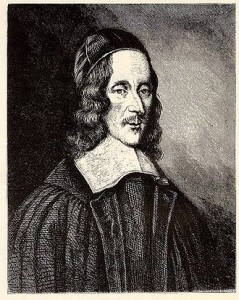[Portrait of George Herbert by Robert White, 1674]
The following review by Frye of books by Rosamond Tuve and Douglas Bush was overlooked in the several bibliographies of Frye’s writing I have compiled over the years. It is therefore not included in volume 28 of The Collected Works of Northrop Frye, Writings on Shakespeare and the Renaissance. I stumbled across a reference to the review when I was doing a database search for something else. The review appeared sixty years ago in Renaissance News 6, nos. 3–4 (Autumn–Winter 1953): 46-8.
Rosemond Tuve. A Reading of George Herbert, Chicago: University of Chicago Press, 1953, 216 p., 17 pl. $5.
Douglas Bush. Classical Influences in Renaissance Literature. (Martin Classical Lectures, Vol. XIII) Cambridge, Mass.: Harvard University Press (for Oberlin College), 1952. 60 p. $1.50.
Miss Tuve’s reading of George Herbert is concerned largely with the scriptural typology in his poetry. She shows that Herbert is unintelligible without some understanding of the tradition of allegorizing Scripture which had become incorporated in the liturgy and which can be found almost anywhere one looks in Herbert’s period: in sermons, in hymns, in the books of hours, in stained-glass windows, in patristic writings, breviaries, glosses and commentaries. She has laid particular stress on pictorial analogues, and the book is handsomely illustrated in consequence. She is not out for source-hunting: her primary aim is to explain the grammar of the language that Herbert spoke.
The assumption that the Bible is one book, rigidly unified in its symbolism, is primary in the typological tradition, and so is the Augustinian principle that the Old Testament is revealed in the New and the New concealed in the Old. It follows that every significant event in the Old Testament typifies the Incarnation, notably the Exodus, the deliverance of God’s people from bondage, which is the keystone of Old Testament symbolism. Miss Tuve shows how such an approach to the Bible clears up Herbert’s use of such images as the Jordan, Joseph’s coat, Naaman, Melchizedek, and the like, and how the use of a Biblical image echoes all the Biblical uses of that image. Thus the vine carried out of the Promised Land typifies Christ the true vine; the cross links with the forbidden tree of Eden and the brazen serpent of the wilderness, the winepress of Isaiah with the blood of Christ, and so on.
The first half of the book deals with the poem ‘The Sacrifice,’ and takes as its starting point the relation of the poem to the liturgy of the Improperia, the ‘Reproaches’ of Good Friday. It is also concerned with Empson’s analysis of the poem in Seven Types of Ambiguity, and illustrates the deficiencies of a criticism which deals only with the linguistic surface of a poem, without knowing its real language, the language that is rooted in convention and cultural tradition. A good deal of Empson’s criticism, especially his remarks about ‘jokes’ and the like, springs from the clichés about the metaphysical style that we have inherited from Johnson’s Life of Cowley. The notion that Herbert is a metaphysical poet of this type was not Johnson’s, and is not Miss Tuve’s: she shows that in many respects Herbert belongs solidly to the allegorical school.
The book is of great value for the study of Herbert, and of even greater value if taken as an introduction to the study of Scriptural typology. One would like to see her do a companion study on Vaughan, whose imagery, for all the nonsense talked about his hermetism, is also Biblical, though less liturgical than Herbert’s. In a way it is rather a reflection on the comprehension of the humanities by the humanists that such a study should have to be written at all. ‘What kind of readers do we make,’ Miss Tuve asks, ‘whom circumstances have intervened to make ignorant of what every literate man once knew?’ The elementary principles of typology are data that no humanist has any excuse for not knowing. If other scholars can be prodded into learning them in order to understand Miss Tuve’s demonstration of the inadequacy of Empson’s critique of Herbert, perhaps we have stumbled on a real function of the new criticism.
Mr. Bush’s two lectures form an excellent introduction to the spirit of Renaissance culture. Generalization and illustration alike are made with a sense of perspective that can only come from great scholarly authority. He knows better, of course, than to distort his subject by taking it too literally. There certainly were Classical influences on Renaissance literature, but it is not possible to distinguish the new influences from the older ones transmitted from the Middle Ages. No one in English criticism has done more to show this than Mr. Bush himself. The genuinely new features—a growing secularization of learning, more knowledge of Greek, better and printed texts, a sharper historical sense, and a number of distinctive developments such as the Senecan Stoicism of Chapman—are lightly but clearly touched. Again, it is not possible to contrast Classical with Christian influences, thereby treating Erasmus and Montaigne as though they accepted the kind of antithesis between Christian superstition and non-Christian enlightenment that one may find later in Gibbon or Shelley. The medieval conception of pagan wisdom as a natural theology contained by the Christian revelation is substantially that of nearly all Renaissance humanists. Hence if one says, for instance, that one Classical influence on Renaissance literature was a sense of form, a good deal of this sense turns out to be simply the medieval sense of cosmological order persisting unchanged. These and other considerations indicate that Mr. Bush’s lucid summary of his subject is not as easy as it looks.
 [
[